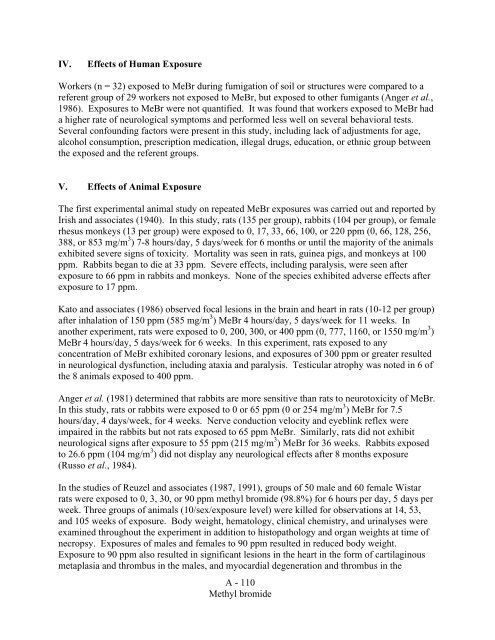METHYL BROMIDE - OEHHA
METHYL BROMIDE - OEHHA
METHYL BROMIDE - OEHHA
You also want an ePaper? Increase the reach of your titles
YUMPU automatically turns print PDFs into web optimized ePapers that Google loves.
IV. Effects of Human Exposure<br />
Workers (n = 32) exposed to MeBr during fumigation of soil or structures were compared to a<br />
referent group of 29 workers not exposed to MeBr, but exposed to other fumigants (Anger et al.,<br />
1986). Exposures to MeBr were not quantified. It was found that workers exposed to MeBr had<br />
a higher rate of neurological symptoms and performed less well on several behavioral tests.<br />
Several confounding factors were present in this study, including lack of adjustments for age,<br />
alcohol consumption, prescription medication, illegal drugs, education, or ethnic group between<br />
the exposed and the referent groups.<br />
V. Effects of Animal Exposure<br />
The first experimental animal study on repeated MeBr exposures was carried out and reported by<br />
Irish and associates (1940). In this study, rats (135 per group), rabbits (104 per group), or female<br />
rhesus monkeys (13 per group) were exposed to 0, 17, 33, 66, 100, or 220 ppm (0, 66, 128, 256,<br />
388, or 853 mg/m 3 ) 7-8 hours/day, 5 days/week for 6 months or until the majority of the animals<br />
exhibited severe signs of toxicity. Mortality was seen in rats, guinea pigs, and monkeys at 100<br />
ppm. Rabbits began to die at 33 ppm. Severe effects, including paralysis, were seen after<br />
exposure to 66 ppm in rabbits and monkeys. None of the species exhibited adverse effects after<br />
exposure to 17 ppm.<br />
Kato and associates (1986) observed focal lesions in the brain and heart in rats (10-12 per group)<br />
after inhalation of 150 ppm (585 mg/m 3 ) MeBr 4 hours/day, 5 days/week for 11 weeks. In<br />
another experiment, rats were exposed to 0, 200, 300, or 400 ppm (0, 777, 1160, or 1550 mg/m 3 )<br />
MeBr 4 hours/day, 5 days/week for 6 weeks. In this experiment, rats exposed to any<br />
concentration of MeBr exhibited coronary lesions, and exposures of 300 ppm or greater resulted<br />
in neurological dysfunction, including ataxia and paralysis. Testicular atrophy was noted in 6 of<br />
the 8 animals exposed to 400 ppm.<br />
Anger et al. (1981) determined that rabbits are more sensitive than rats to neurotoxicity of MeBr.<br />
In this study, rats or rabbits were exposed to 0 or 65 ppm (0 or 254 mg/m 3 ) MeBr for 7.5<br />
hours/day, 4 days/week, for 4 weeks. Nerve conduction velocity and eyeblink reflex were<br />
impaired in the rabbits but not rats exposed to 65 ppm MeBr. Similarly, rats did not exhibit<br />
neurological signs after exposure to 55 ppm (215 mg/m 3 ) MeBr for 36 weeks. Rabbits exposed<br />
to 26.6 ppm (104 mg/m 3 ) did not display any neurological effects after 8 months exposure<br />
(Russo et al., 1984).<br />
In the studies of Reuzel and associates (1987, 1991), groups of 50 male and 60 female Wistar<br />
rats were exposed to 0, 3, 30, or 90 ppm methyl bromide (98.8%) for 6 hours per day, 5 days per<br />
week. Three groups of animals (10/sex/exposure level) were killed for observations at 14, 53,<br />
and 105 weeks of exposure. Body weight, hematology, clinical chemistry, and urinalyses were<br />
examined throughout the experiment in addition to histopathology and organ weights at time of<br />
necropsy. Exposures of males and females to 90 ppm resulted in reduced body weight.<br />
Exposure to 90 ppm also resulted in significant lesions in the heart in the form of cartilaginous<br />
metaplasia and thrombus in the males, and myocardial degeneration and thrombus in the<br />
A - 110<br />
Methyl bromide















